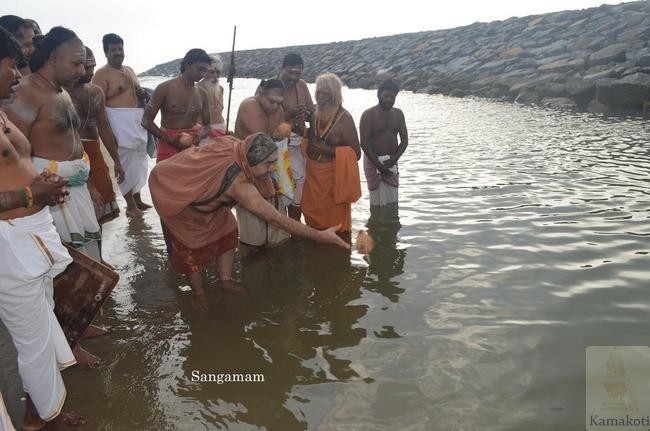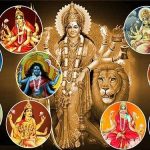On the Occasion of the Kaveri Pushkaram, let us travel through important Pushkar Ghats, which are also centers of piligrimage which also have beautiful and Popular Temples across the river Kaveri, in two states, Tamil Nadu and Karnataka.
Sri Ranganathswamy Temple, Trichy (Tamil Nadu)
The Sri Ranganathaswamy Temple or Thiruvarangam is a Hindu temple dedicated to Ranganatha. Constructed in the Tamil style of architecture, this temple is glorified in the Thiviya Pirabandham, the early medieval Tamil literature canon of the Alvar saints from the 6th to 9th centuries AD and is counted among the 108 Divya Desams dedicated to Vishnu. The temple follows Thenkalai tradition of worship.

After Mayiladuthurai, the government has planned many activities at Srirangam.
Must Read Kaveri Pushkarams 2017 : All Your Need to Know
Thiruvaiyaru Shiva Temple, Thanjavur (Tamil Nadu)
Thiruvaaiyaru has an old Siva temple dedicated to Panchanatheeswar. Though pilgrims flock to this temple throughout the year, Thiruvaiyaru is more renowned for its association with Saint Thyagaraja, who, along with Muthuswami Dikshitar and Shyama Sastri, comprised the Trinity of Carnatic music. Thiruvaiyaru means Five Rivers around the city.

The Five Rivers are Arisilaaru, Vennaaru, Vettaaru, Kudamuruttiyaaru and Kaveriaaru. The Thyagaraja Aradhana festival is held in January when most of the leading exponents of Carnatic music come to perform and are watched by thousands of ardent fans of classical music. A best place to have Kaveri Pushkara Snanam and visit the temples, as the iconic Brihadeeshwara Temple too is near.
Swamimalai Subramanya Temple, Thanjavur (Tamil Nadu)
Swamimalai is a panchayat town near Kumbakonam in Thanjavur District in the Indian state of Tamil Nadu. It lies on the banks of river Kaveri and is one of the six abodes of the Lord Muruga. According to Hindu mythology, Karthikeya explains the meaning of pranavam to His father Lord Shiva at Swamimalai. Hence, one can see the Karthikeya depicted as Guru (teacher) and Shiva listening as shishya (disciple) in the gopuram of the temple complex. The God is given by the name Swaminathan and Thagapan Swami (literally Father of God).

Again a best place to have the Pushkara Snanam (bath) at Swamymalai, as the Temple town Kumbakonam is near and one can have a beautiful pilgrimage.
Must Read : #KnowYourRiver : Kaveri
Kumbakonam, Thanjavur (Tamil Nadu)
Kumbakonam dates back to the Sangam period and was ruled by the Early Cholas, Pallavas, Medieval Cholas, Later Cholas, Pandyas, the Vijayanagar Empire, Madurai Nayaks, Thanjavur Nayaks and the Thanjavur Marathas. It rose to be a prominent city between the 7th and 9th centuries AD, when it served as a capital of the Medieval Cholas. The town reached the zenith of its prosperity during the British Raj when it was a prominent centre of European education and Hindu culture; and it acquired the cultural name, the “Cambridge of South India”.

There are around 188 Hindu temples in Kumbakonam. Apart from these, there several thousand temples around the town thereby giving the town the name “Temple Town”. More popular Temlpes in Kumbakonam are Nageswara Temple, Sarangapani Temple, Adi Keswara Temple, Kasi Vishwanathar Temple. So for a Kaveri Pushkara Snanam this is the best place to visit this weekend.
Sri Pallaveneswara Temple, Poompuhar (Tamil Nadu)
Pallavaneswarar Temple is a Hindu temple located in the town of Kaveripoompattinam or Poompuhar, it is an archaeological site in Tamil Nadu. The temple is dedicated to Lord Shiva. T Lord Shiva is a swayambumurthy in the temple and his consort is known as Soundaryanayaki. This is the birth place of saint Pattinathar. It is one of the shrines of the 275 Paadal Petra Sthalams – Shiva Sthalams glorified in the early medieval Tevaram poems by Tamil Saivite Nayanar Tirugnanasambandar.

Poompuhar is a beautiful place, with Kaveri Pushkarams, one can combine the Pushkara Snanam and the pilgrimage to this place.
Chenna Kesava Temple – Mysore (Karnataka)
Chenna Kesava Temple is a Vaishnava temple dedicated to lord Hari or Krishna. This was built in 12th Century by Hoyasala Kings of South Indian kingdoms. Its symmetrical architecture, fine sculptures on equally prominent shrines, and panel sculptures form a cloister that speak of good taste. While there are Hoysala temples with better sculpture and others with better architecture, this temples satisfies all requirements. According to the Mysore archaeological reports, it was built by the famous architect and sculptor Ruvari Malithamma who was well known for his expertise in ornamentation. It has worldwide recognition for its Marvelous architecture and sculptures. This was built under the reign of King Narasimha III.

This Temple can be choosen for the Pushkara Snanam (Bath) as one can combine both the Architectural exploration and the spiritual pilgrimage.
Sri Bhagandeshwara Temple – Bhagamandala (Karnataka)
Bhagamandala was known in ancient times as Bhaganda Kshetra. Long ago one great sage namely Sri Bhaganda Maharshi was living here in his ashrama with his disciples. Therefore, the place was named after the great rishi Sri Bhaganda as Bhagamandala. A short distance from the triveni sangama, there is a famous temple known as Sri Bhagandeshwara temple, where Bhagandeshwara (Ishwara), Subramanya, Mahavishnu and Ganapati idols are installed. This place is also known as Bhagandeshwara Kshetra, from which the name Bhagamandala is derived. The temples in this area are built in Karavali(West Coast) style.

It is a common practice for pilgrims to take a dip in the triveni sangama and perform rituals to their ancestors before proceeding to Talakaveri, the birthplace of Kaveri. The holy bath in Triveni sangama in Bhagamandala is a must visit place for Kaveri pushakara snanama (bath).
Sri Ranganathaswamy Temple, Srirangapattanam (Karnataka)

Sri Ranganathaswamy Temple is a famous for Hindu Temple dedicated to Ranganatha. Its is one of the five importanat pilgrimage sites with river Kaveri. These five sacred sites are together known as Pancharanga Kshetrams in Southern India. An inscription at the temple reveals it was first consecrated in 984 A.D. by a local chief called Tirumalaiah, a vassal of the Western Ganga dynasty. In early 12th century, Hoysala King Vishnuvardhana (r.1108-1152) granted the village of Srirangapatna to the Vaishnava saint Ramanujacharya as an agraharam (place of learning). An inscription of the great Hoysala King Veera Ballala II (1210 A.D.) confirms that additions and renovations were made to the temple at that time.[2] The tower over the entrance bears features consistent with Vijayanagara architecture. The king Vishnuvardhan was granted a village to Srirangapatna in 12th century.
This would be a great place to visit for the Pushkara Snanam (bath).
Sri Venugopala Swamy Temple, Somanathapura (Karnataka)
The Venugopala Swamy Temple located at Hosa Kannambadi, Near Krishna Raja Sagara, is another example of Hoysala architecture in Karnataka. This temple was built in the 12th century AD around the same time as the Chennakesava Temple at Somanathapura, Mysore district. the Venugopala Swamy temple complex and 2 other temples namely Kenneshwara (Ishwara) temple and Kalamma (A local deity) temple had to be abandoned. By 1930, the first phase of the dam was completed and all three temples were submerged. The main idol of Venugopalaswamy, Lord Krishna playing on flute as a cow-herd, was shifted to a new temple in the rehabilitated village before the submersion.

It is also famous place for holy bath at time of Kaveri pushkar snanam (bath).
Nimishamba Temple, Srinrangapattanam (Karnataka)
Enroute to Mysore from Bangalore, one can find the Nimishamba temple, which is famous for its history, culture and religious significance. Located on the banks of Cauvery river, this ancient temple is dedicated to Goddess Nimishamba, believed to be an incarnation of Goddess Parvati.

The stone ‘Sri Chakra’ kept in front of the idol of a deity has an interesting legend associated with it. It is said that the founder of this holy spot was Muktharaja, a king, who inscribed the ‘Sri Chakra’ before going into penance. The stone is said to have been established during the reigns of Mummadi Krishnaraja Wodeyar, around 400 years ago.
The main attraction of the temple lies in the beautiful carving on the temple tower, which highlights some exquisite paintings. The various idols of Ganesha, Hanuman and the cement structure of goddess Lakshmi and Sarawati are also a major draw among tourists.
There are many more sight seeing places around this Temple and Srirangapattanam, its palace being few of them, making this place a best place to plan for this Kaveri MahaPushkaralu.
——————









